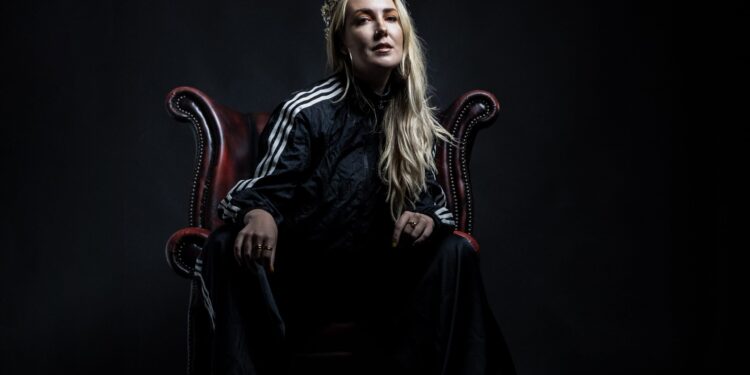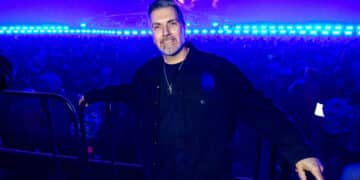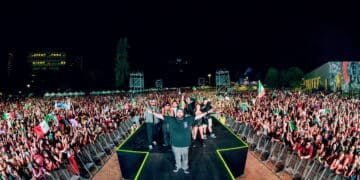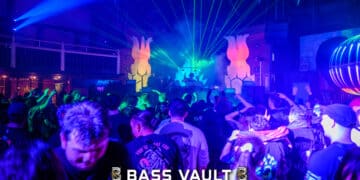Indo Warehouse’s rise in the scene and their journey to Coachella are remarkable as they continue to lay the groundwork for the global Indo-house movement.
When Indo Warehouse took the Gobi stage earlier this month, they made Coachella history as the first South Asian dance music collective to perform at the landmark festival. Their performances featured live dhol drummers as well as bhangra and garba dancers.
Founded by Armaan Gupta (Kahani) and Kunal Merchant, the New York-based collective has rapidly become a force in the dance music community by uniting deep house and techno with South Asian lyrics, rhythms, dance, and sounds. In three years, they’ve gone from intimate NYC underground shows to wrangling a 40-person creative motley crew of dancers, producers, content creators, and artists.
The collective features performances from Anvaya, comprised of singer and songwriter Sonia and producer and multi-instrumentalist Kaushal; dance teams Raas Ruckus and Baaghi Bhangra; singers HYDR and PDNY; and drummer Nihal Singh and his dhol drumline.
Kahani and Kunal sat down with us at the festival and eloquently shared their experiences on the road to Coachella. The collective heads delved deep into the intergenerational throughlines of dance music and folk art, their goal of inspiring the next generation of South Asian creatives, and the process of filling the void of Indo-house music.
Check out Indo Warehouse – Dholna – Live at Coachella 2025 on YouTube:
Thanks for taking the time to speak with me. Tell me a little bit about the collective. How did it come about? How we’re here at Coachella 2025. It’s your debut. How do you feel?
Kahani: Great. Feel great…we have probably one of the biggest teams throughout the entire festival. We’re rolling with 40-plus people on our team between dancers, performance artists, personnel, and content… Within three years, our North Star goal of hitting Coachella is here. And that’s kind of one of the highlight pieces everyone talks to us about. They’re like, “Wow, getting to Coachella in three years is crazy.” But we kind of called it in the beginning. We just kept pushing through, and now we’re here.
You had a vision?
Kunal: Yeah, absolutely. I think the ideas were percolating for a little bit, but we just felt there’s a space where South Asian culture belongs in music across the board. but we felt really because of the emergence of global music and dance music specifically, we’re like, our music belongs here. And so I think that’s why we were really confident from the jump, this could be here.
Right before our first party, he said on camera that we should be at Coachella, and now we’re here. And I think what’s happening in a very short amount of time is we’re just seeing people resonate with that mission, that South Asian culture fuses with dance music in an authentic way. It’s just the vibe. And you’re going to see that today. And it’s not one-sided, it’s not a track, it’s not a vocal, it’s not a rhythm, it’s everything. And today’s show is going to showcase the diversity of ways that this belongs together.

Tell me about the lore of Indo Warehouse. Take me back to where it all started, how you two decided that this was kismet, that this was what was going to happen in three years.
Kahani: Both of us have loved music our whole lives, but something that we bonded over is the fact that Kunal has a deep love for dance music for years and years and everything from traveling to seeking artists around the world. And on the flip side, I mean, I did love dance music, but my knowledge base was more in the South Asian space, understanding that world. And I’ve loved South Asian music and dance, specifically when I say ‘dance,’ not just dance music but the folk art of certain dance forms in India.
We spent the first year focusing mainly on New York. The first party was in February 2022, a 200-person event on the Lower East Side. We made a mission to double our capacity every month or every two months and see where it goes. And we did that. We had an amazing opportunity at the end of the first year, where we were throwing a party with an 800- to 900-person capacity in Williamsburg. Somehow, that venue fell through, and we got introduced to the folks at Avant Gardner, home of Brooklyn Mirage. They actually offered us King’s Hall, with an 800-person capacity. They announced it. We sold out in a day, and the next day, they were like, “Do you want the Great Hall?” which has a 3,000-person capacity.
We said, “Let’s do it.” And we went on sale the next day, within two weeks, that was almost sold out. Within one year, [we had] a show at one of the most prestigious venues in the country. And then right after that, we got signed to UTA, we then did a North America tour, we hit Europe, and then we got our opportunity at Brooklyn Mirage. And now we’re in our third year. We’ve pretty much hit every continent except South America. South America, we’re coming for you. South America and Antarctica.
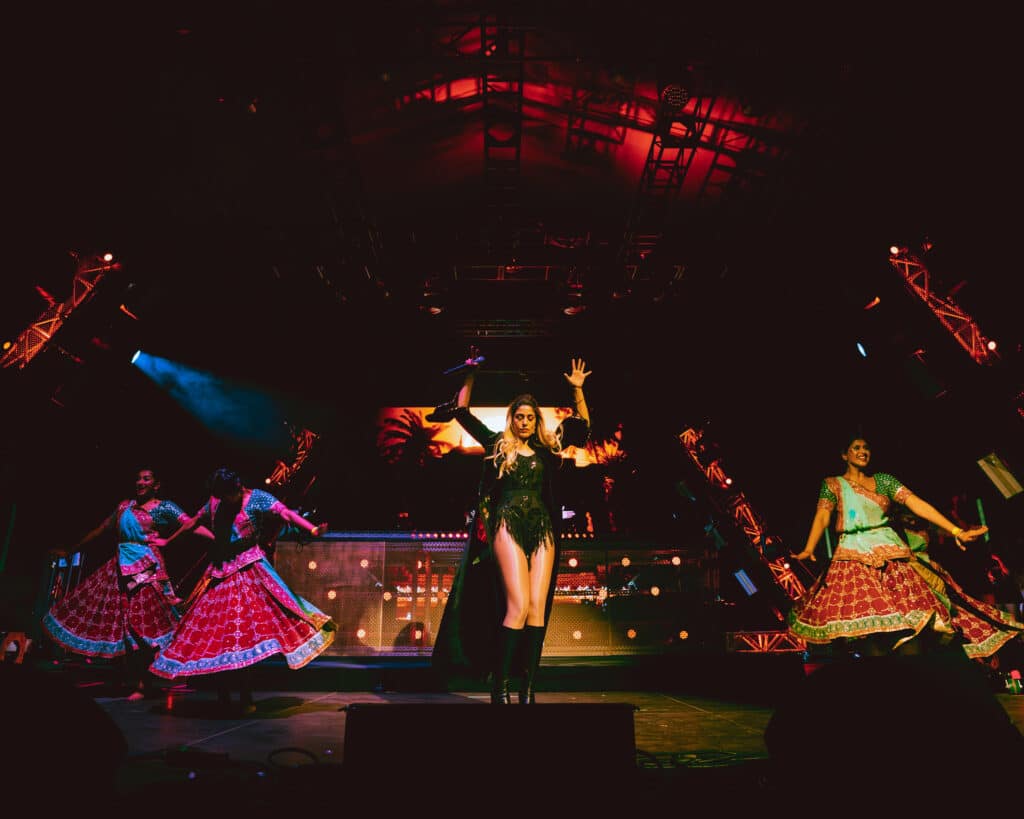
Tell me more about your expertise in South Asian dance forms and folk arts if you’d like to share.
Kahani: Yeah, so specifically, my family on my mom’s side – my mom is partially Punjabi. So Punjabi is a state in Northwest India that also overlaps with Pakistan as well. And there’s a beautiful dance form that originates there called Bhangra. I started learning it in college during my freshman year, and I very quickly became the captain of the dance team.
I started freelancing as a dancer for other teams… So it was something I loved. Dance is a great expressive form – I did that for 10 years. And I think when we started [Indo Warehouse], there’s this deep desire to figure out how to bring some of that energy to our stage authentically. We talk all the time about how the art of DJing and performance can come together. You’ll see at our show today that we not only incorporate Bhangra, but also another dance for Garba-Raas, which comes from the state of Gujarat. We have live drummers, so we’re experiential first at all times.
Kunal: And I’d say that we’re beyond music and dance. We’re really focused on South Asian creativity across the spectrum. Both of us are South Asian designers from the fashion side; we’re very focused on fashion and the emerging designers that we can support. We have always found a big gap in the market that doesn’t highlight South Asian creativity. Both of us have been doing this in various different ways throughout our lives. And now we can do that. We built the platform.
Do you think that keeps you going?
Kunal: Without a doubt. I mean, I think that’s the thing that we always talk to people about. This is bigger than us. We’re not a duo called Indo Warehouse. We’re a collective. And I think it’s really important for us because we don’t find success in just one piece of this puzzle. We really think that we’re just simple proof of concept. What we’re doing today at Coachella is not the end goal by any means. We believe there are so many talented South Asian artists and creators around the world. We want to shine a spotlight on them. And so we’ve been able to do that in three years, but in 10 years, we think we’ll put a lot of people on.
How did you get into dance music?
Kunal: I grew up in Texas. I got into house music, listening to the radio. On weekends, there were mixed shows, which often featured remixes of popular songs, but that’s how it started. But then I actually experienced a rave for the first time, and my mind was blown. It just took me down a path of constant consumption of dance music. And I just became obsessed. And I never wanted music to be my profession just because of the same things that a lot of South Asian kids feel: you can’t do this as a profession, it’s not stable.
But in my entire life, the one constant I’ve had is my love for dance music. And it’s taken me to amazing places that helped me experience so many things, helped me meet so many friends… and brought me to Coachella.
Kahani: Dance music, I would say, is somewhat new to me, but I will say that when I was in college, that was the era of Swedish House Mafia, Afrojack – it was a beautiful era. I think when that era started to slow down a bit, I very quickly separated from it. But I had still, at that time, never been to a festival. I’d never been to a concert in my life. So, my first concert was just four or five years ago – Blink-182. And, I mean, I’m a drummer, so watching Travis Barker was insane.
[Later on] I ended up moving to Mexico, and I was on a beach in Tulum. That’s for the first time when I was immersed in dance music, and I’m like, “Wow, this sounds different. What is it? This music is not music that I’m hearing on the radio. It’s not music that the algorithm is giving me.” And I went down that rabbit hole, and that’s around the same time that I started to question why I’m not hearing our language or languages on top of these beats.
You hear Latin House, you hear Afro House… And at that time, I didn’t have a name for [Indo House], but I’m like, it has to exist. But then I realized no one was doing it. I dove deeper. I was trying to find that. So, in my pursuit to find that, I found more and more music. And that’s where the idea spawned. And now we’re doing it.
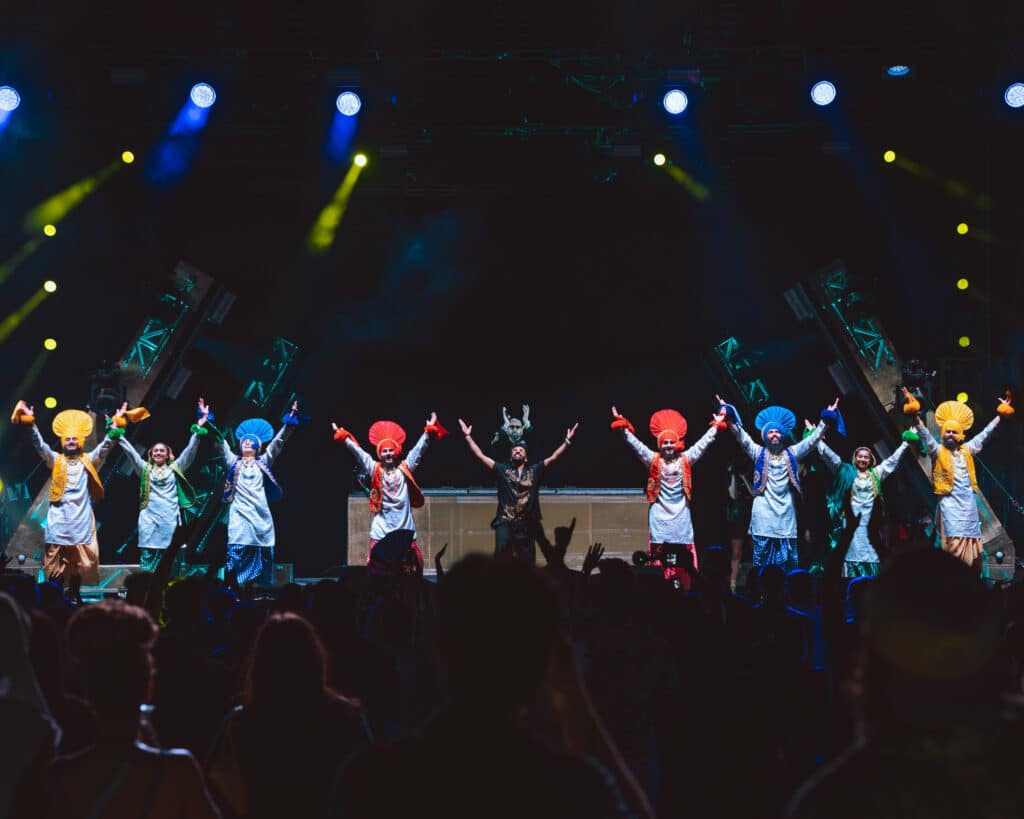
Do you feel that dance is inseparable from the roots of South Asian culture?
Kahani: Yeah. I mean, when we talk about the folk dance forms, those are so ingrained in our culture. India, specifically, is composed of a ton of micro-cultural cultures and regions amongst all of them. All these different areas have different ways of celebrating different things. So, the dance that I learned was created because during harvest season, the farmers needed a way to celebrate, and they created this dance form out of celebration. The moves that you’re going to see on stage come from imitating harvest season. There’s a move that imitates wheat flowing in the wind. A lot of this is so integral to our culture, but growing up, you don’t think twice about it because you’re just immersed in it.
You watch Bollywood films, and you listen to the music, and you don’t think twice about it. But as you get older, once you start asking questions and dive deeper, you’re like, “Wow, there are reasons behind all this.” So we have the pleasure now of going to India, returning to the motherland, to give them what we’ve been creating.
The first time we went on tour in India, there was a little layer of anxiety. How is it going to be? Are we going to be accepted? Because, again, no one is doing what we’re doing. We are the equivalent of what punk rock was here for India.
Kunal: We’re of Indian origin, but we don’t live in India. How are they going to view us? But they accepted us with open arms. And our first show in Mumbai was 8,000 people.
Indo Warehouse is the only collective on the Coachella lineup. What precedent does that set?
Kunal: Yeah, I mean, honestly, we think that we’re kicking the door open and hopefully helping people get a sense that our culture isn’t one-dimensional. There’s so much. And honestly, what we’re seeing in the buzz we’ve gotten off of the first week’s show is that what we’re doing is resonating. Whether they’re an artist or just someone who’s enjoying Couchella, they’re absolutely just enamored by the fact that we’re putting our culture in the front of the stage.
A lot of what we’re showing today is a combination of the past, present, and future. And we’re really excited because that creates a throughline with people, whether they’re seventy years old or 12 years old. In the background, the two of us are working with 10 to 15 artists that are emerging. They’re doing amazing things.
You’re continuing traditions for the newer generation.
Kunal: We want to show people that our culture is as relevant as anything else in a simple world. To say, “Hey, we’re cool. Remember that.” We’re saying, “Look within yourselves, you have it.”
See, we’re born with music. Literally, the moment you’re born, people are singing, it’s religious or folk songs, to every point of your life. Music is a part of our culture.
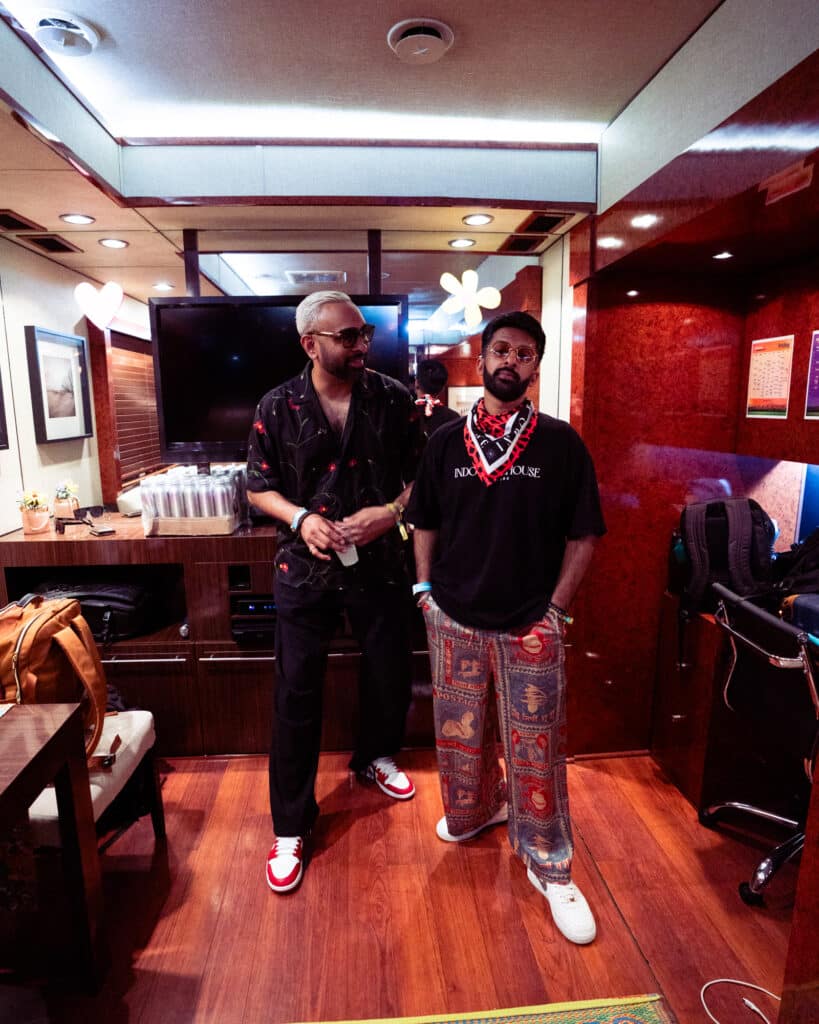
Perhaps there is a curious connection between religion and raving. How do you feel about that?
Kahani: Rave is a religion. I think that what we do has no real religious tie but rather a cultural one. But the thing is that we want to just show people that it’s okay to do what we do, whether it be performing, whether it be making music, whether it be wearing certain clothes.
Our parents came here as first-generation immigrants, and when they arrived, they wanted us to be doctors, lawyers, and engineers. But that’s also because if I wanted to become a painter, they were like, “There’s no South Asian painter who is successful.” That’s what they think. They don’t have an example to look at.
So we win if, after tonight, a five-year-old says, “I want to play the guitar” or “I want to DJ,” and their parents say, “Oh yeah, I saw this [collective] doing it. Okay, you can do it, at least try.”
Kunal: Some of our dancers who go to college right now, and they were telling me today that they’re walking in between Coachella, they got to class or they’re walking to class, and someone’s like, oh, I saw you at Coachella. You were performing. That’s so dope. Our goal is to inspire the next generation.
Follow Indo Warehouse:
Website | Instagram | SoundCloud | YouTube



